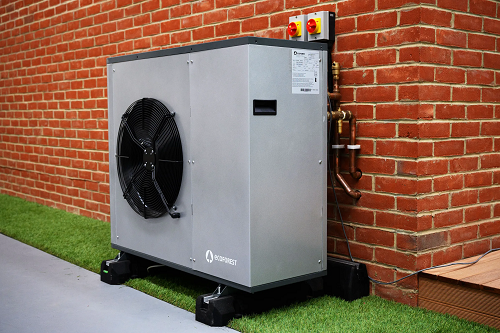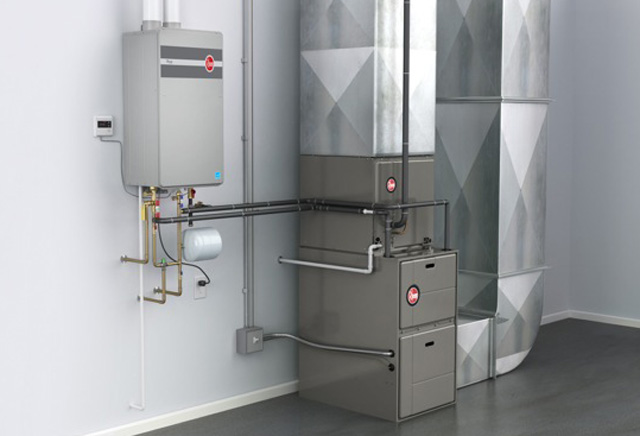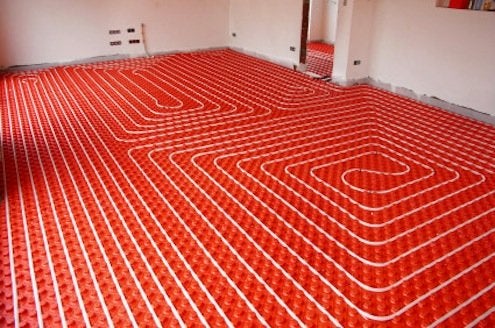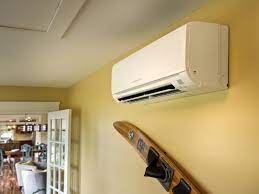The quest for warmth becomes paramount as the frigid Canadian winters descend upon us. The importance of finding the most energy-efficient heating systems cannot be overstated in a country where heating expenses can account for a significant portion of Canada’s diverse climate, which ranges from the icy tundra of the North to the milder coastal regions of the South, demands adaptable and eco-friendly solutions to keep homes comfortable without breaking the bank.
In this article, we embark on a journey to explore the best energy-efficient heating systems tailored specifically for the unique demands of Canadian homeowners. Whether you reside in the snowy reaches of Alberta, the maritime provinces of the East Coast, or the urban centres of Ontario and Quebec, we have scoured the heating market to bring you a comprehensive guide on staying warm while minimizing your environmental footprint and reducing energy costs.
Heat Pumps

Regarding energy-efficient heating systems, heat pumps stand out as a top choice. They are a versatile and eco-friendly option that can efficiently provide heating and cooling for your home.
· Air Source Heat Pumps (ASHP): These systems extract heat from the outdoor air and can provide both heating and cooling. They are efficient, especially in milder climates.
· Ground Source Heat Pumps (GSHP): Also known as geothermal heat pumps, GSHPs use the ground’s stable temperature to heat efficiently and fabulous homes, making them suitable for various regions in Canada.
How Do Heat Pumps Work?
At the core of a heat pump’s operation is moving heat from one place to another rather than generating heat directly. This process makes heat pumps highly energy-efficient. Here’s a breakdown of how they work:
1. Heat Extraction: In colder months, when you need heating, the heat pump extracts warmth from the outdoor air (in the case of air source heat pumps) or the ground (for ground source heat pumps).
2. Heat Transfer: The extracted heat is transferred to a refrigerant fluid circulating within the heat pump system. The liquid absorbs the heat and turns it into a gas.
3. Compression: The heat-laden gas is compressed, raising its temperature significantly. This process requires minimal energy, making heat pumps highly efficient.
4. Heat Release: The hot gas releases heat indoors through a coil or radiant system, warming your home.
5. Cycling: The refrigerant then returns to its liquid state, and the cycle repeats as needed to maintain a consistent indoor temperature.
Energy Efficiency Benefits
Heat pumps offer several energy-efficient advantages:
1. High Efficiency: Heat pumps typically have high coefficients of performance (COPs), producing more heating or cooling energy than the electricity they consume.
2. Dual Functionality: Heat pumps can heat and cool your home, reducing the need for separate heating and cooling systems.
3. Environmentally Friendly: Since they move heat instead of generating it, heat pumps produce fewer greenhouse gas emissions, making them environmentally responsible choices.
4. Zoning: Ductless mini-split heat pumps allow for zoned heating, letting you control the temperature in specific areas of your home, saving energy.
5. Consistent Comfort: Heat pumps ensure consistent heating throughout your home, eliminating any uneven hot and cold areas.
6. Quiet Operation: They operate quietly, enhancing your home’s comfort without disruptions.
Choosing the Right Heat Pump
To maximize the energy efficiency benefits, consider the type of heat pump that suits your climate. Air-source heat pumps work well in milder temperatures, while ground-source (geothermal) heat pumps excel in colder regions.
Consulting with an HVAC professional can help you select the best option for your location.
High-Efficiency Furnaces:

High-efficiency furnaces are a top choice when it comes to keeping your house comfortable and warm during Canada’s harsh winters. These advanced heating systems offer several advantages, but they also come with some considerations.
Advantages of High-Efficiency Furnaces:
1. Energy Efficiency: High-efficiency furnaces are designed to extract more heat from the burnt fuel. They typically have Annual Fuel Utilization Efficiency (AFUE) ratings of 90% or higher, meaning they convert at least 90% of the fuel into usable heat.
2. Cost Savings: High-quality furnaces can substantially reduce your heating costs over time due to their enhanced efficiency. While they may have a higher initial purchase price, the long-term savings often outweigh the upfront investment.
3. Environmental Benefits: These furnaces produce fewer emissions, making them environmentally friendly. Lower energy consumption and reduced carbon footprint contribute to a greener home heating solution.
4. Quiet Operation: Many high-efficiency furnace models are engineered for quiet operation, ensuring your home remains comfortable without disruptive noise.
5. Zoning Capabilities: When paired with zoning systems, high-efficiency furnaces allow you to customize the temperature in different areas of your home, optimizing comfort and saving energy.
Cons and Considerations:
1. Initial Cost: High-efficiency furnaces are more expensive upfront than standard-efficiency models. However, the long-term savings in energy bills often offset this initial cost.
2. Fuel Source: Natural gas or propane availability in your area may influence your choice of high-efficiency furnace, as these fuels are commonly used.
3. Maintenance: These furnaces may require more frequent maintenance to continue operating efficiently. Annual inspections are recommended.
Types of High-Efficiency Furnaces:
1. Condensing Furnaces: These are the most common type of high-efficiency furnace. They utilize condensing technology to extract additional heat from combustion gases by passing them through a secondary heat exchanger.
2. Modulating Furnaces: Modulating furnaces adjust the heating output in small increments to match the exact heating needs of your home. This results in consistent, even warmth and maximum energy efficiency.
How High-Efficiency Furnaces Work:
High-efficiency furnaces burn natural gas or propane to produce heat for your home. Here’s a simplified breakdown:
1. Combustion: The furnace’s burner ignites the fuel, creating a flame.
2. Heat Exchanger: Heat from the flame is transferred to a primary heat exchanger, which warms the air circulating through your home’s ductwork.
3. Condensing: In high-efficiency furnaces, hot combustion gases are directed to a secondary heat exchanger, releasing more heat and condensing into water vapour. This additional heat extraction boosts efficiency.
4. Distribution: The now-warmed air is distributed throughout your home via the ductwork and vents.
5. Air Return: Cooler air returns to the furnace to be reheated, continuing the cycle until your desired indoor temperature is achieved.
Radiant Floor Heating:

Radiant floor heating is an innovative and efficient method of keeping your home warm and cosy, particularly in colder Canadian climates.
Advantages of Radiant Floor Heating:
1. Even Heat Distribution: Radiant floor heating systems distribute heat evenly across the floor, eliminating cold spots and providing consistent warmth throughout your living space.
2. Energy Efficiency: These systems are highly energy-efficient because they operate at lower temperatures while effectively heating your home. They can work well with various heat sources, including solar and geothermal.
3. Space-saving: Radiant floor heating doesn’t require bulky radiators or ductwork, which can free up space in your home and allow for more flexible interior design.
4. Reduced Allergens: Without forced-air systems, less air movement and fewer allergens are circulating in the indoor air, making it an excellent choice for those with allergies.
Cons and Considerations:
1. Installation Cost: The upfront installation cost of radiant floor heating can be higher than traditional heating systems, particularly if retrofitting an existing home.
2. Installation Complexity: Installing radiant floor heating requires expertise and planning, making professional installation essential.
Types of Radiant Floor Heating Systems:
1. Hydronic Radiant Floor Heating: This system circulates heated water through pipes or tubing in the floor, providing a consistent and efficient source of warmth.
2. Electric Radiant Floor Heating: Electric heating cables or mats are installed under the flooring, which generates heat when electricity passes through them. They are typically more accessible and less expensive to install than hydronic systems.
How Radiant Floor Heating Works:
Radiant floor heating systems work based on the principle of thermal radiation. Here’s a simplified breakdown of how they operate:
1. Heat Source: For hydronic systems, a boiler or water heater warms the water. For electric systems, electricity passes through heating elements.
2. Distribution: In hydronic systems, heated water is pumped through a network of tubing installed beneath the floor. In electric systems, heating cables or mats are placed on the subfloor.
3. Radiant Heat Emission: The heat radiates upward from the floor’s surface, warming the objects and people in the room. This is different from forced-air systems that primarily heat the air.
4. Thermostat Control: A thermostat regulates the temperature, allowing you to set and maintain your desired comfort level.
Solar Heating Systems:
Solar heating systems are an environmentally friendly and sustainable solution for providing warmth to homes, even in the Canadian climate.
Advantages of Solar Heating Systems:
1. Renewable Energy Source: Solar heating systems harness energy from the sun, a renewable and virtually limitless resource, reducing reliance on non-renewable fuels.
2. Energy Savings: Solar heating systems can yield significant energy savings, especially in regions with ample sunlight. They can supplement or even replace traditional heating sources.
3. Environmentally Friendly: Solar heating produces no direct greenhouse gas emissions, creating a cleaner and more sustainable environment.
4. Long-Term Investment: While the upfront costs can be substantial, solar heating systems offer long-term savings on energy bills and a return on investment over time.
5. Low Maintenance: Solar heating systems are relatively low maintenance, with minimal moving parts and a long lifespan.
Cons and Considerations:
1. Initial Cost: The installation cost of solar heating systems, including solar panels and associated equipment, can be relatively high.
2. Weather Dependency: Solar heating systems depend on sunlight, making their effectiveness variable, especially during cloudy or overcast periods.
Types of Solar Heating Systems:
Solar Air Heating: This system uses solar collectors to heat air, which is circulated through the home using fans or blowers.
Solar Water Heating: Solar collectors heat water, which can be used for heating your interior space or domestic hot water. There are two main types:
- Active Solar Water Heating: This system uses pumps to circulate water or heat-transfer fluid through the collectors and into a storage tank.
- Passive Solar Water Heating: These systems rely on natural convection to move water through the collectors and into the storage tank.
How Solar Heating Systems Work:
Solar heating systems harness energy from the sun to provide warmth. Here’s a simplified explanation of how they operate:
1. Solar Collectors: Solar panels or collectors are installed on the roof or in another location where they can capture sunlight.
2. Absorption of Solar Energy: The collectors absorb solar energy and convert it into heat. The collected heat is used to warm air directly in solar air heating systems. In solar water heating systems, the heat is transferred to water.
3. Heat Transfer: Solar water heating systems utilize a heat-transfer fluid, typically a blend of water and antifreeze, to absorb heat from the collectors and transport it to a storage tank.
4. Distribution: In water heating systems, the hot water from the storage tank is circulated to radiators, in-floor heating systems, or domestic hot water taps. In solar air heating systems, warmed air is circulated through ducts to provide space heating.
5. Thermostat Control: A thermostat or controller regulates the heated air or water distribution, maintaining the desired temperature.
Ductless Mini-Split Systems:

Ductless mini-split systems are gaining popularity as an efficient and adaptable solution for heating and cooling requirements in both residential and commercial environments.
Advantages of Ductless Mini-Split Systems:
1. Energy Efficiency: Ductless mini-splits are highly energy-efficient thanks to their zoned heating and cooling ability.
2. No Ductwork Required: Unlike central HVAC systems, ductless mini-splits don’t require ductwork. This makes installation easier, reduces heat loss, and preserves indoor air quality.
3. Customized Comfort: Each indoor unit is independently controlled, allowing you to set different temperatures for different zones or rooms, ensuring personalized comfort.
4. Compact and Flexible Design: Ductless systems are compact and blend seamlessly with various interior designs.
5. Quiet Operation: Ductless mini-splits operate quietly, minimizing disruptions in your living space.
Cons and Considerations:
1. Upfront Cost: The initial cost of installing ductless mini-split systems can be higher than traditional systems. However, energy savings can offset this cost over time.
2. Aesthetic Impact: The indoor units can be noticeable and may not suit all interior design preferences.
Types of Ductless Mini-Split Systems:
1. Single-Zone Systems: These consist of one outdoor unit and one indoor unit, perfect for heating or cooling a single room or area.
2. Multi-Zone Systems: Multi-zone systems enable the connection of several indoor units to a single outdoor unit, enabling independent heating or cooling of multiple rooms or zones.
How Ductless Mini-Split Systems Work:
Ductless mini-split systems work on a straightforward principle of heat exchange and refrigerant circulation:
1. Heat Absorption: In heating mode, the outdoor unit absorbs heat from the outside air, even in cold temperatures. In cooling mode, it absorbs heat from indoor air.
2. Refrigerant Circulation: The absorbed heat is transferred to a refrigerant gas in the outdoor unit. The refrigerant circulates through a closed-loop system.
3. Heat Exchange: The indoor unit(s) contain a coil connected to the refrigerant circuit. As the refrigerant circulates through this coil, it releases heat into the indoor air during heating mode or absorbs heat from the indoor air during cooling mode.
4. Distribution: The indoor unit’s fan distributes the conditioned air into the room, either heating or cooling it based on the mode selected.
5. Thermostat Control: You can control each indoor unit separately using a remote or a wall-mounted thermostat, enabling you to adjust the desired temperature for each specific zone.
